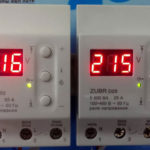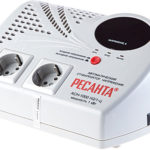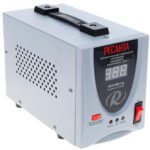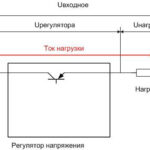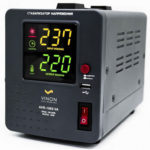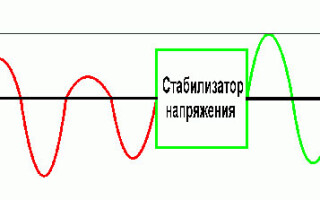The electricity supplied to your houses and apartments has its own specific standards. For example, if the mains voltage is 220 V, the deviation should be no more than 10 percent of the nominal value. Such a run-up in the amount of voltage can adversely affect the proper functioning of household electrical appliances and lighting fixtures.
Specialized organizations that supply electricity use transformers designed to convert electrical quantities. From them comes electricity to houses and apartments.
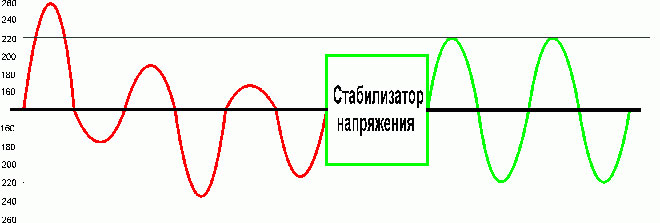
The line shows the lower voltage limit when working under heavy load. If in the future the load increases, the regulatory limit goes down, this is due to the depletion of the substation capacity. A network with a voltage of 380 V works on the same principle, this is easily explained by the operating mode of the installations under standard conditions. If you look at the picture more realistically, then in the cold season the supply of residential premises with a voltage level is lower than in the summer.
Reference. Voltage drops and its unstable operation can be corrected with the help of special stabilizers, the function of which is to normalize the current parameters. Stabilizers are widely used in different places, they have a fairly budgetary cost, and are easy to install and connect. All work related to the stabilizer can be done independently, without resorting to the help of specialists.
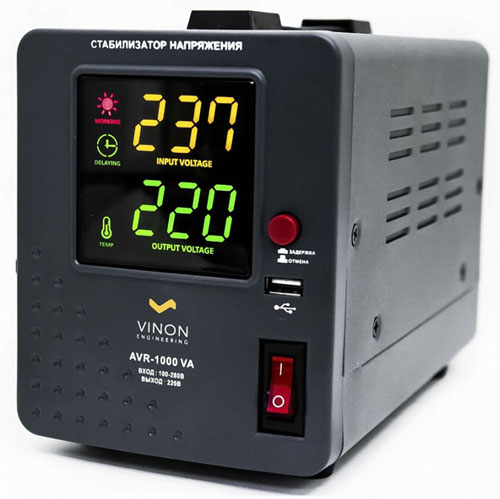
Content
Determining the type of protection
To date, stabilizers are divided into 2 main types:
- stationary devices for voltage stabilization, their installation is done for the whole house;
- portable models, they can stabilize the operation of just a few electrical devices.
Also, stationary stabilizers are divided into single-phase and three-phase, it all depends on the conditions in which they plan to operate. In your house or apartment, it would be more appropriate to install and connect a stabilizer near the electricity distribution board, with this step you can prevent failures and overloads of the entire network.
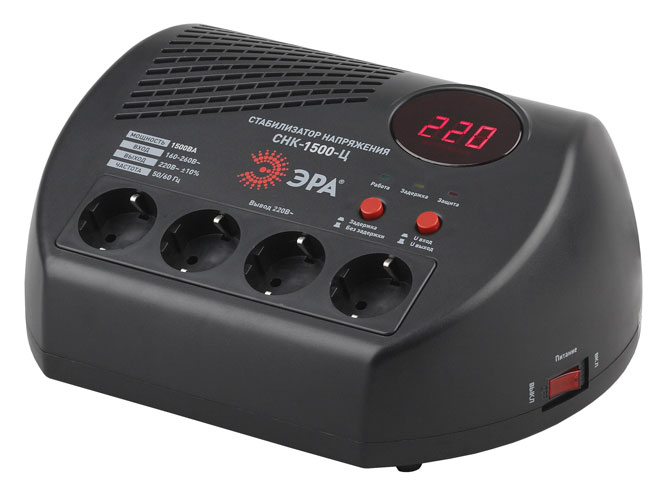
Choice of mounting location
Important! If you decide to install an electricity stabilizer yourself, all responsibility for the serviceability of the device falls on your shoulders. You must strictly follow all the requirements and rules of the PUE.
There is a specific list of recommendations regarding choosing the right place to install an electric power stabilizer:
- The room where the installation is planned should be with a minimum level of humidity, and always well ventilated. Such conditions must be observed to minimize the risk of moisture entering the device;
- If the installation of the stabilizer will be carried out in small enclosed spaces (for example, in a cell near the electric power distribution board), think in advance that the facing materials in this area are not combustible and flammable;
- Be sure to leave a gap of at least ten cm between the stabilizer box and the wall;
- When attaching an electric power stabilizer to the wall, take care in advance to fix it as securely as possible, and also to make its location convenient for operation.
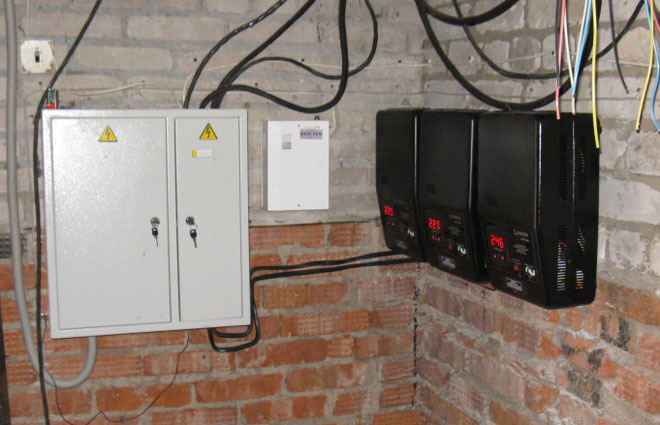
What you need to connect
To connect a single-phase power stabilizer, you will need:
- single phase stabilizer.
- Three-core cable VVGnG-Ls (the cross section of this cable must be identical to your input cable, which is located on the breaker itself or on the main input machine). Through this cable will pass the load of electricity to the entire house.
- 3 position switch. It differs from standard switches in that it can be in three states.
- Multi-colored wire type PUGV.
This switch will have three states:
- Connected through a stabilizer;
- Bypass, i.e. without a stabilizer - dirty food;
- Turned off.

Important! During the connection process, you can also use a modular type machine. But it should be borne in mind that when using such a scheme, if you need to turn off the power stabilizer, you will be forced to turn off the power throughout the house every time and switch the wires.
With a three-position switch, you can cut off the stabilizer with one simple movement, leaving the living space with electricity directly.
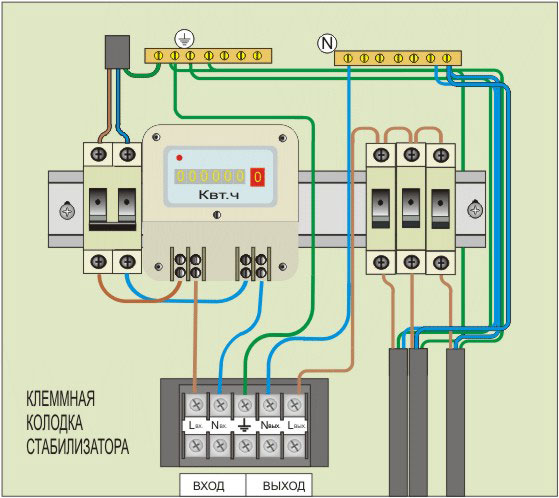
Remember that a single-phase power stabilizer must be installed after the electricity meter.
Even when the power stabilizer is operating at minimum load, it is idling and consumes a small amount of energy, which must be taken into account and accurately calculated.
There is another important point. In a house where it is planned to install a single-phase stabilizer, it is desirable to have RCD or differential machine. This is a recommendation from the leading brands of stabilizers in the world markets. Examples of such companies are:
- Resanta;
- Sven;
- Leader, etc.
A device that protects equipment from power outages can be a conventional introductory differential machine.
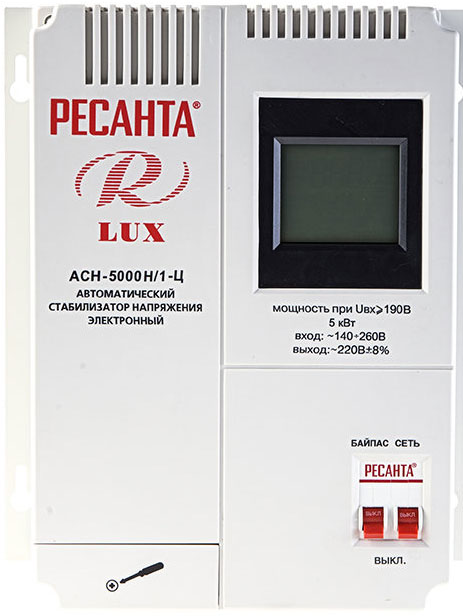
Connecting the stabilizer
Connection diagram of a single-phase power stabilizer in a network with a voltage of 220 Volts
Important! When connecting stabilization equipment, first turn off the electricity in the house! This is one of the main safety rules.
To comply with this rule, you need to turn off the introductory machine, which is located in the switchboard, then you need to check again if the electricity is turned off. For these purposes, use a special index.
Basically, the stabilizer turns on immediately after the voltage is applied. The power stabilizer has a sequential type of inclusion. A small cheat sheet for you can be the connection diagram of the stabilizer, applied to its body by the manufacturer.
A single-phase stabilizer has three contacts that are involved in the connection process:
- A phase wire is taken from the introductory machine and connected to the “entry” place in the wire connection block at the stabilizer;
- Connect the phase wire responsible for load distribution to the “output”;
- Last step. Find the zero contact of the stabilizer, and connect it to the neutral wire of the network, avoiding a break.
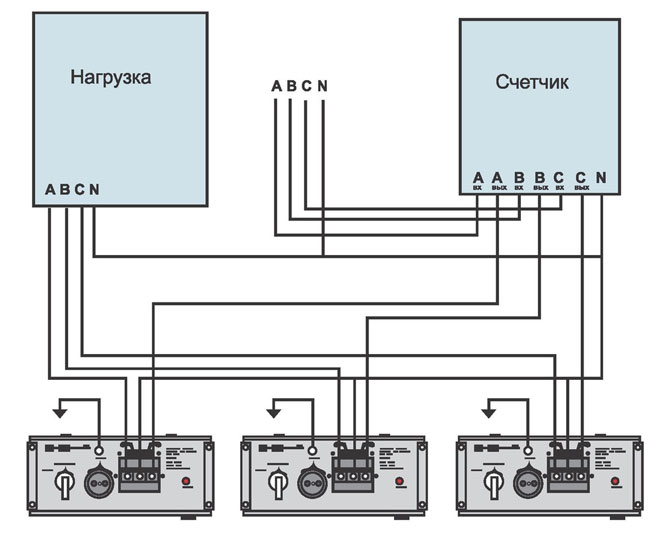
The neutral wire must first be connected to the stabilizer, then to the common neutral wire of the network.
What to do if there are 4 contacts on the stabilizer body for connecting
It happens that when examining an electricity stabilizer, you can immediately observe 4 contacts for connection. It looks like this:
- phase - "input";
- 0 - "input";
- phase - "exit";
- 0 - "exit".
If there is such a circuit in the voltage stabilizer, the connection to the network is as follows:
The neutral and phase wires of the electrical panel are connected to the corresponding contact, called the "input" on the body of the protective device. In this case, the neutral and phase wires responsible for the load are connected to the contacts marked "output".

When the installation process comes to an end, double-check that you have connected all the wires correctly. Before turning on the device for the first time, it is necessary to de-energize all electrical appliances and remove all plugs from the sockets.
When the stabilizer turns on, carefully monitor the correct operation of its operation. It should work quietly without extraneous noise in the form of crackling, etc.
Important! In order for the voltage stabilizer to work effectively and reliably once a year, it is necessary to carry out preventive maintenance, which consists in tightening the bolts and screws. Timely implementation of such a procedure will help minimize the risk of fire or deformation of the insulating layer, which can be caused by a deformed or loosely tightened contact.
Also, on sale you can find voltage regulators with low power (P<1.5 kW). They are produced as a complete stand-alone unit, complete with a cord for connecting to the mains with a standard plug. There are several sockets on the surface of the device case.
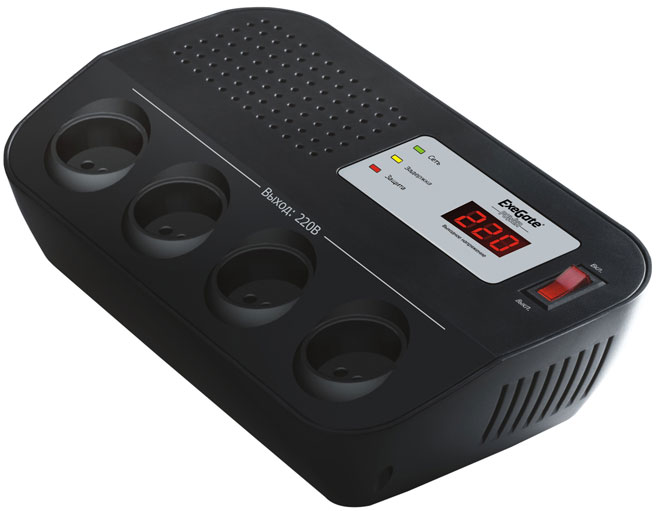
Any electrical device whose operation you want to protect from risk is connected to the voltage stabilizer through such an outlet. Based on this, we can conclude that devices that protect electricity and devices based on it are a kind of additional link between the load and the electrical network, which provide reliable protection against power surges and network overload.
Schema health check
If your house has a three-phase network with a voltage of 380 V, it is recommended to use three single-phase voltage stabilizers at once for connection. Each must be connected strictly in a separate phase.
When connecting the stabilizer to the network for the first time, it is necessary to exclude all possible load. All machines must be turned off.Only the introductory machine should remain working, and the machine that goes directly to the stabilizer. As soon as you connect the power stabilizer. It will start idling, and your task is to control its operation. Watch for extraneous noises (they should not be normal), pay attention to the input and output voltage parameters, and also check the correctness and accuracy of the technical data that can be seen on the meter's electronic screen.
Connection errors
The most common mistake in connecting a single-phase voltage stabilizer is the wrong choice of location for installation or the wrong location of the device. Even with the correct connection of the circuit and compliance with all recommendations, the voltage regulator may overheat and turn off, there will be constant malfunctions and errors on the display.
Incorrect switching of the stabilizer from operating mode to bypass. For the transition, you must adhere to the exact sequence. Namely:
- Disconnection from the power supply of the machines directly on the instrument panel;
- Change the normal position of the switch to "bypass" or "transit";
- Only after performing the above actions, you can re-enable the machines.
Important! Many people mistakenly underestimate the importance of complying with such rules, and change the position of the switch under power, which ultimately leads to device malfunction or breakdown.
When connecting the stabilizer, a wire with a smaller cross section was used. Be sure to adhere to all the necessary cable parameters, taking into account the total load of the house.
There are no ferrules on stranded conductors. Do not save on tips, buy them immediately after purchasing a single-phase stabilizer. According to the rules of the PUE, terminations for stranded conductors are required
Knocks out the machine in the electrical panel. There is also such a problem, given that when the stabilizer is turned off, everything functions normally without failures. Many people in such situations mistakenly believe that the device is faulty, or they sin by incorrectly connecting the circuit and taking the stabilizer for repair under warranty. But the reason may lie in a completely different problem. For example, you have insufficient voltage in the network, 150 V, instead of the prescribed 220 V. If the voltage is normal, the current in the network will become an order of magnitude higher.
Be sure to pay attention to all the problems mentioned above before taking the stabilizer to the store and claiming it is defective.
Similar articles:
